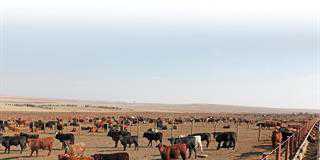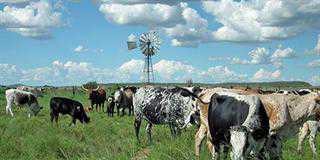Internal parasites
- Roundworms: With the good rains that fell in large parts of the country reports of internal roundworm parasitism were received. Numerous reports were also received of game dying from wireworm infestation. As wireworm resistance to anthelmintics is widespread, consult your vet in selecting the anthelmintic groups still able to control the parasites on your farm. Problems with brown stomach worm were also reported from the Western Cape. Ask your vet to explain the concept of refugia to you when using dewormers.
- Tapeworms: Infestations were reported in Mpumalanga, Gauteng, Limpopo, North West, Free State and the Eastern and Western Cape.
- Parafilaria: Causes ‘false bruising’, which leads to the downgrading of the carcass at slaughter. Animals should be treated 70 days before slaughter to allow the lesions to heal. Reports were received from Limpopo, North West, Free State and KwaZulu-Natal.
- Flukes: Reports were received from Mpumalanga, Gauteng, Free State, KwaZulu-Natal and the Western Cape. A blood test can be done to establish whether the animal has liver fluke.
Immature conical flukes cause severe diarrhoea. Reports of this were received from Mpumalanga, Limpopo, Free State, KwaZulu-Natal and the Eastern Cape. Young animals are especially susceptible. Take care when new animals are brought into an area.
- Cysticercosis (measles): Reports were received from Mpumalanga, Gauteng, KwaZulu-Natal and the Western Cape. Seek out the origin of the infestation and put in place preventative measures.
- Coccidiosis: Numerous reports from all provinces were received, except North West and the Northern Cape. Young animals are especially affected when conditions are wet and muddy. Discuss preventative measures with your vet.
External parasites
Ticks: There was a huge increase in blue tick numbers. Make sure that the control measures used are effective. Blue ticks transmit African and Asiatic red water, anaplasmosis, lumpy skin disease and cause blood loss.
Reports of the presence of the following tick species were received:
- Blue tick: All provinces except the Northern Cape
- Heart water tick: Mpumalanga, Gauteng, Limpopo, North West, KwaZulu-Natal and the Eastern Cape
- Brown-ear ticks: Mpumalanga, Gauteng, Limpopo, North West, Free State and KwaZulu-Natal
- Bont-legged ticks: All provinces, except Eastern and Northern Cape. The toxin of this tick causes sweating disease, and the ticks are spreading – reports were received from areas where they are not generally found.
- Red-legged tick: Mpumalanga, Gauteng, Free State and KwaZulu-Natal.
- Paralysis ticks: Free State and KwaZulu-Natal.
Discuss the life cycles of these ticks and how to control them with your vet, keeping in mind the selection for tick resistance. Engorged blue ticks can be collected and tested for resistance. Contact your vet for information regarding the test.
Do not use home made pour-ons as this is a sure way of selecting for tick resistance and having residues in the meat.
Actives that are used to control ticks are: organophosphates, amidines, pyrethroids, tick development inhibitors (fluazuron) and, for blue ticks, macrocyclic lactones.
- Lice: Whether sucking or biting, numbers are decreasing. Farmers with wool sheep should check their sheep regularly for lice as they cause serious disturbance of the fleece. There is serious red lice resistance to drugs and therefore farmers should be aware of buying in sheep with lice.
- Mites: Be on the lookout for disturbances in wool and hair loss. Sheep scab is a state-controlled disease. Contact your State Veterinarian to hear whether there are positive farms in your area. Biosecurity measures to prevent sheep becoming infected should be in place at all times.
- Flies, midges & mosquitoes: Numbers are on the increase after good rains in many parts of the country. Numerous reports of nuisance flies, blowflies, screw-worm and nasal bot were received. Be on the lookout for diseases carried by these insects. Ticks with long mouth parts (bont and bont-legged ticks) cause wounds which are the ideal spot for screw-worm flies to deposit their eggs. The macrocyclic lactones will kill the larvae.
Tick borne diseases
- African and Asiatic red water: Reports were received from all provinces except the Northern Cape, and the occurrence of these diseases is on the rise as blue tick numbers increase. Discuss vaccination programmes with your vet. Asiatic red water is a killer and proper steps should be taken to control this disease! Be especially alert when introducing new animals into red water areas.
- Anaplasmosis: Numerous reports of outbreaks were received from all provinces except Limpopo and the Northern Cape. This disease is spread by blue ticks, biting flies and needles (vaccinations). Discuss vaccinating cattle with your vet.
- Heartwater: Reports were received from all provinces except the Free State and Western and Northern Cape. The occurrence of this disease is spreading as a result of game transporting the bont tick into non-infected areas. Discuss control measures with your vet to prevent heavy losses.
Insect transmitted diseases
- Lumpy skin disease: Reports were received from all provinces. Most cases occurred in animals that had never been vaccinated. If there is an outbreak on a farm the virus can also spread via the saliva, therefore isolate diseased animals as soon as possible. Several vaccines are available and all animals should be vaccinated annually.
- Three day stiff sickness: An increase in the occurrence of this disease was reported from all provinces except the Northern Cape. Vaccine is not available and serious economic losses were recorded.
- Blue tongue: Reports were received from North West, Free State, KwaZulu-Natal, Eastern and Western Cape. There is a crisis with the availability of vaccine. Discuss additional control measures with your vet.
- Rift Valley Fever and Wesselsbron disease: No reports were received.
Venereal diseases
Trichomonosis continues to cause havoc. It is of utmost importance that biosecurity measures are in place.
Bacterial diseases
The following bacterial diseases were reported: blackquarter, pulpy kidney, swelled head, red gut, blood gut, tetanus, botulism, salmonellosis, bovine brucellosis, ovine brucellosis, Johnes, enzootic abortion, colibacillosis, lumpy wool and senkobo.
For most of these diseases there are vaccines. Discuss the risk factors for the diseases in your area with your vet and put together a control programme.
Viral diseases
The following viral diseases were reported: Bovine malignant catarrh (snotsiekte), rabies (Gauteng, Limpopo, North West and Free State), infectious bovine rhinotracheitis (IBR), bovine viral diarrhoea (BVD), enzootic bovine leucosis (EBL), orf and warts.
Bovine respiratory disease (BRD) with high mortality figures was reported from all over the country.
Poisonings
The following were reported: cardiac glycoside, tulip, ink berry (Cestrum), Cynanchum (klimop), facial eczema, dikoor, geeldikkop, Senecio, blue green algae, prussic acid, mycotoxicosis, organophosphate, ionophor, lead, urea, hypo, copper, lead, nitrate, acidosis and snake bite.
Nutritional
The following deficiencies were recorded: energy, protein, phosphate, calcium, iodine, copper, zinc, selenium, manganese, magnesium, vitamins A and B1. Liver, blood and bone samples can be taken by your vet to get a profile of the micro and macro mineral status of your animals. Take water and soil samples too. The results will help establish if there are antagonists present which will lower the uptake of minerals.
Multifactorial diseases & other conditions
The following were reported: abscesses, bladder stones, blindness, opthalmia, eye cancer, bloat, blood gut, blue udder, mastitis, diarrhoea, joint ill, lameness, navel ill, stomach ulcers, trauma, downer cows and pneumonia.
Feedlot Report
Sheep feedlots
- Wireworm infestation generally increased, as did nasal bot infestation.
- A few cases of pulpy kidney and diarrhoea occurred.
- Pneumonia occurred in weaker lambs.
- Foot rot and foot abscess were seen due to wet conditions and bont-legged tick bites.
- A few sheep had problems due to abscesses.
Cattle feedlots
- Opthalmia was seen in many young calves.
- Pneumonia occurred due to wet conditions after the rain.
- A few liver abscesses accompanied by rumen damage were seen.
- Acidosis with bloat and red gut caused mortalities.
- Tick burdens increased and cases of sweating sickness, anaplasmosis and red water were recorded.













